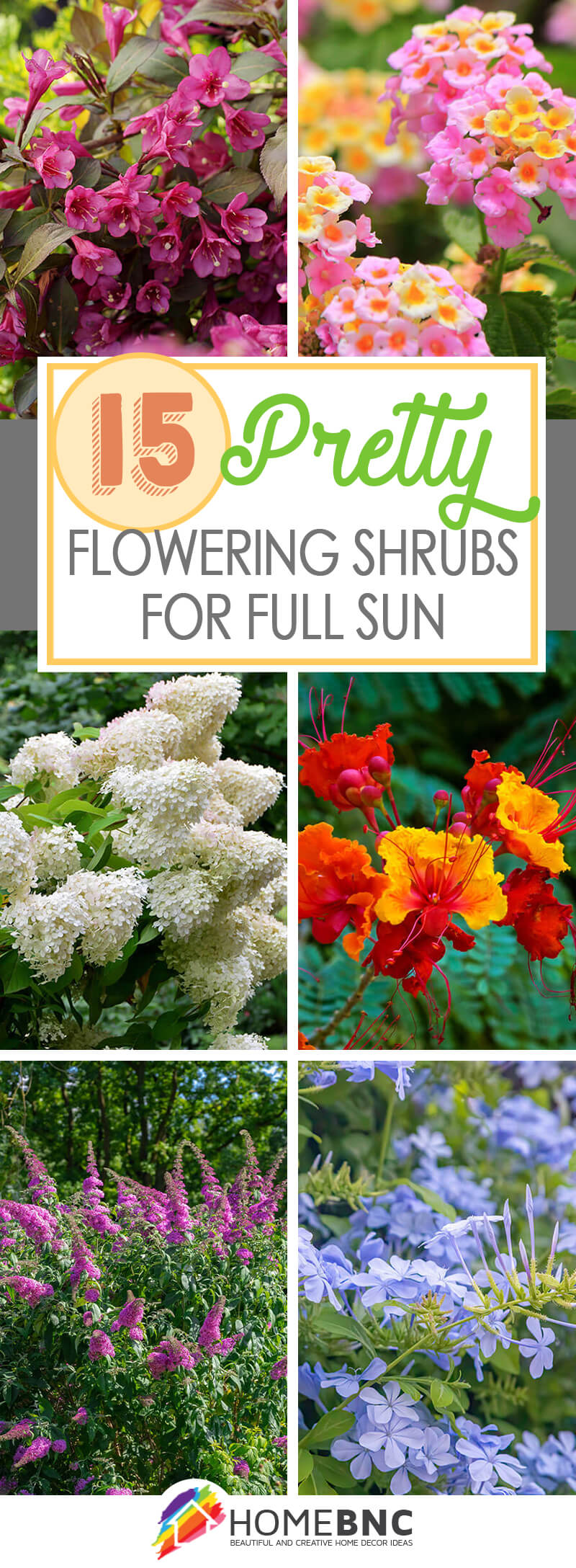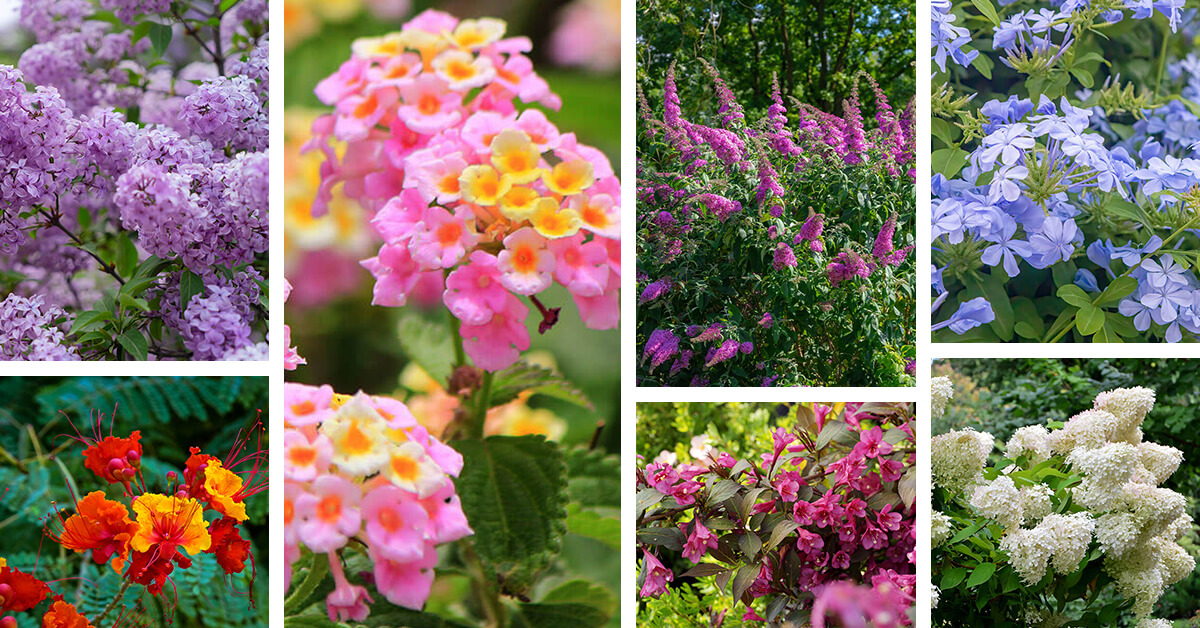The right shrub can really elevate a garden, whether in a neat border or a striking accent. Shrubs are a great way to add bulk and structural variety to a garden – and all the better if they’re blooming shrubs! It’s no surprise that some of our most beloved ornamentals are flowering shrubs: roses, lilacs, and azaleas, to name just a few.
There’s so much variety among shrubs: not just blooms, but sizes, shapes, foliage, texture… It can be a little overwhelming, and you might be tempted to just go with a tried and true classic – but you might be missing out! If you’re considering planting a flowering shrub or two but aren’t sure where to start, well – start here! Below, you’ll find fifteen of the best flowering shrubs for full sun: from hardy natives to exotic tropical beauties, from pert and compact to big and leggy, you’re certain to find something you like – and maybe a surprise or two!
Key Takeaways
- Flowering shrubs love full sun – and if you want to maximize blooms, you’ll need to maximize exposure, too. Plants need a lot of energy to make flowers – and the more flowers, the more energy they need.
- Not all “full sun” shrubs are created equal, though. Some shrubs love light and heat, while others need lots of sunlight but can’t tolerate high temperatures. Generally, shrubs that can stand the heat won’t do well in climates with harsh winters – and vice versa.
- Water use is also an important consideration when choosing a shrub: unlike annuals and perennials, a quick soaking isn’t always enough for a large shrub. Many native species can thrive on very little water, but keep in mind that the most drought-tolerant plants are often vulnerable to root rot in wetter climates.
- Most shrubs bloom in spring or summer: just like many perennials bloom later than annuals, woody plants often bloom even later than perennials. This isn’t always the case, however: shrubs like flowering quince and forsythia bloom quite early, often before spring has even begun!
- When choosing a shrub, pay attention to its pruning needs: many flowering shrubs are very picky about pruning, depending on whether they bloom from new growth or old wood. Clip the wrong branch, and you might never see blooms there again! Then again, some shrubs can handle extreme pruning, and in colder climates, this can prevent the plants from being damaged by frost.
- Remember that native shrubs are almost always easier to grow than exotic ones, because they’re adapted to the local climate. Low-maintenance exotic shrubs often become problematic, because they escape from cultivation and become invasive. If you’re worried that native shrubs aren’t as beautiful as exotic ornamentals, well – you’re in for a surprise!
15 Flowering Shrubs for Full Sun to Elevate Your Garden
1. Butterfly Bush (Buddleja ‘Lo and Behold’)
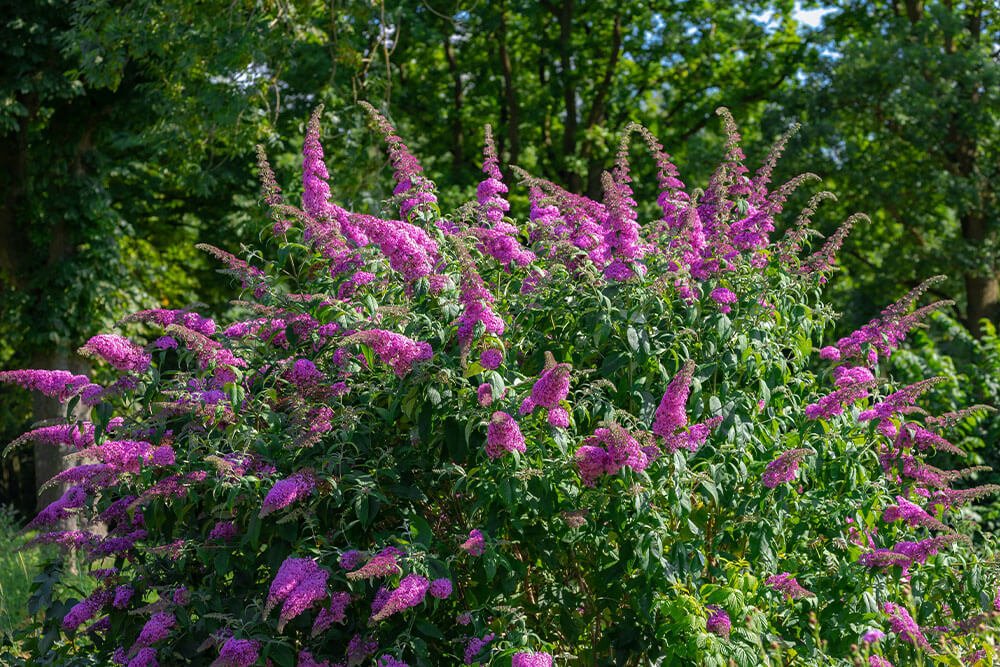
Butterfly bush has almost everything a gardener could want in a shrub: it’s drought-tolerant, frost-hardy (to Zone 5), deer-resistant – and of course, its showy blooms, which — as the name suggests — are just as attractive to pollinators as they are to gardeners, Unfortunately, butterfly bush also has a reputation for becoming invasive, and has even been banned for sale in some states.
However, recently a number of sterile hybrids have been approved for sale that have all of the plant’s good qualities – and there are a lot of them! – while losing the bad. Sterile varieties like ‘Lo & Behold’ don’t skimp on vibrant blooms, but the seeds they produce don’t germinate, ensuring that this garden powerhouse stays in your garden. To maximize your blossoms, prune your plants hard in winter and deadhead spent inflorescences throughout the season.
2. Hydrangea (Hydrangea paniculata)
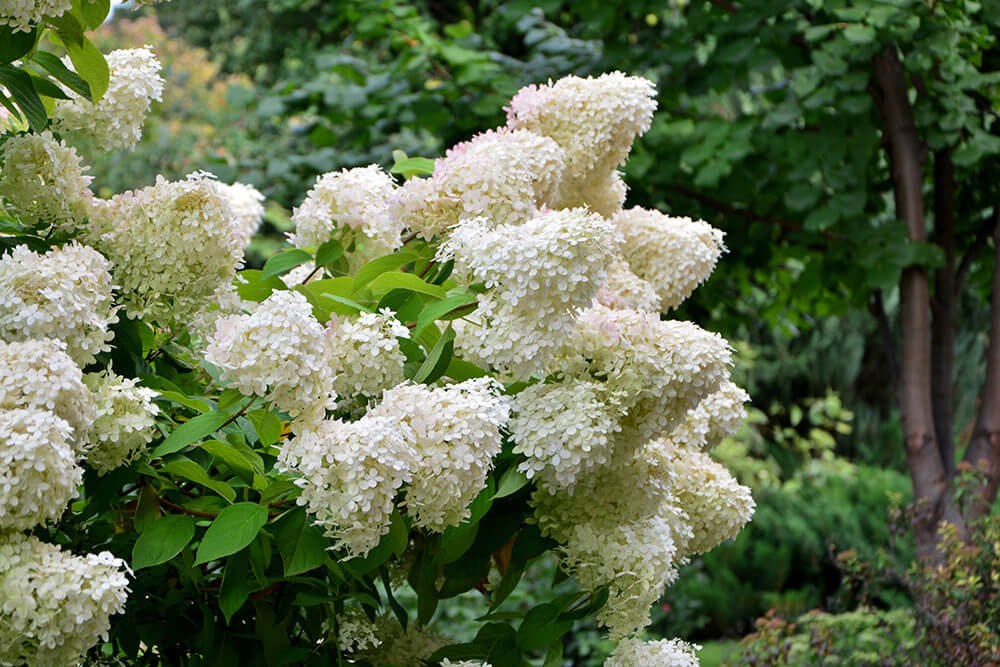
Hydrangeas are quintessential summer garden staples: elegant and showy yet surprisingly tough. If you’ve investigated growing hydrangeas, though, you’ll know already that they’re not all created equal: among the more than 70 species in the genus Hydrangea (plus hybrids), you’ll find a huge range of colors, habits, and needs.
While most of the commonly available hydrangeas are shade-loving shrubs, panicled hydrangea (Hydrangea paniculata) is a notable exception: its elegant, long-lasting spikes of blossoms are at their best in full sun. Their love of direct light makes them among the most frost-hardy species (all the way up to Zone 3!). And if you like your plants low-maintenance, panicked hydrangeas might be just the thing: since they flower from new growth, you can prune them all the way back to the ground, and still get a full complement of flowers next summer.
3. Plumbago (Plumbago spp.)
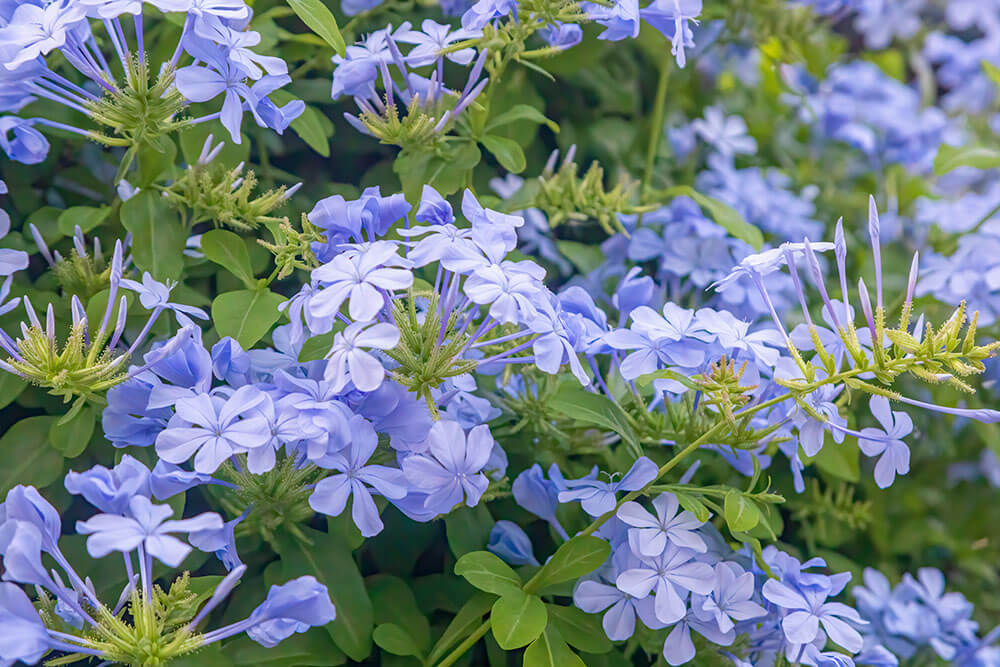
Plumbago is a full sun fanatic. Also called leadwort, this tropical beauty — which looks a bit like leggy garden phlox (Phlox paniculata) — blooms as long as the weather is warm enough. In the southern half of the country, this means an easy five or six months of continuous flowering – and gardeners south of zone 9 might never have to bid adieu to their lovely steely-blue blossoms.
Apart from their workaholic blooms, plumbagos are also quite drought-tolerant, and generally require very little maintenance apart from deadheading spent inflorescences. Unfortunately, their hardiness doesn’t extend to cold weather: plumbagos don’t overwinter in-ground north of zone 8. Gardeners in colder climates aren’t totally out of luck, though: they also make great container plants!
4. Lilacs (Syringa spp.)
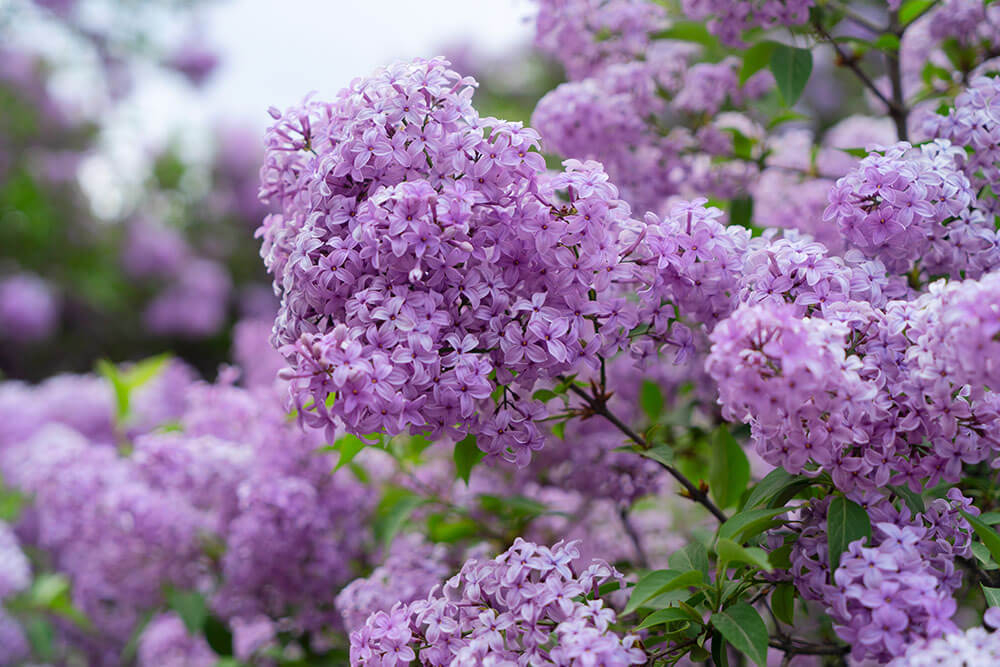
Lilacs may not be the garden’s most popular ornamental shrubs, but there’s a reason that they appear again and again in songs, poems, and literature —- heck, they even have their own color! Lilacs are true icons, right down to their diva work ethic: they only bloom for two weeks out of the year, but do it so profusely that the smell of their flowers can trigger asthma attacks!
Lilacs have one other trait that makes them attractive garden plants: namely, they’re easy to grow! And with literally hundreds of cultivars and varieties available – from densely-petaled “French” lilacs to ‘Bloomerangs,’ which will flower two or three times in a single season – finding a perfect lilac for your garden should be no trouble at all.
5. Weigela (Weigela florida)
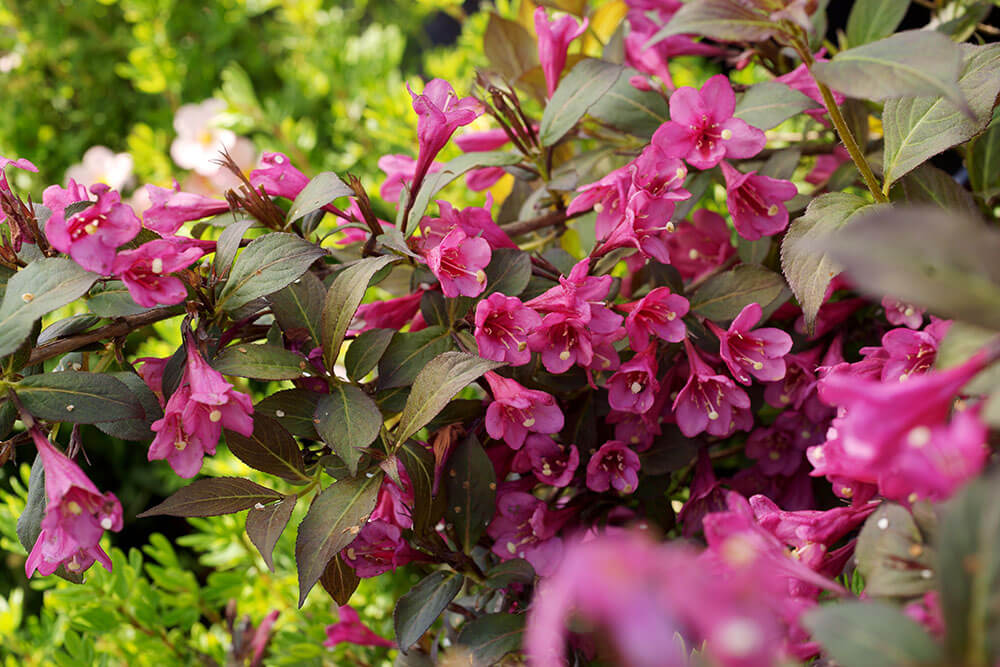
Weigela is one of the most popular ornamental shrubs in the country, and it’s easy to see why. It’s best known for its extravagant flowers, which come in a range of pinks and reds and which bloom twice a year, in mid-spring and late summer.
But weigela is far from a “one-season wonder”: its foliage is as lovely as its blossoms, and comes in an incredible range of colors, from the vibrant green of the wild cultivar to the moody crimsons of cultivars like “Midnight Sun” and “Midnight Wine.” It’s equally beloved as a foundation plant because of its versatility: dramatic and fountain-like when left to grow free, yet easily shaped if a more clean-cut look is needed.
Weigelas are some of the larger shrubs on this list, and they have a tendency to spread: unpruned specimens can reach ten feet high and at least as wide. Pruning in early growth helps to keep weigelas in shape (though this should always be done when the plant is blooming, so you don’t accidentally remove all the flowers), but there are also plenty of dwarf varieties that will fit in almost any space.
6. Lantana (Lantana spp.)
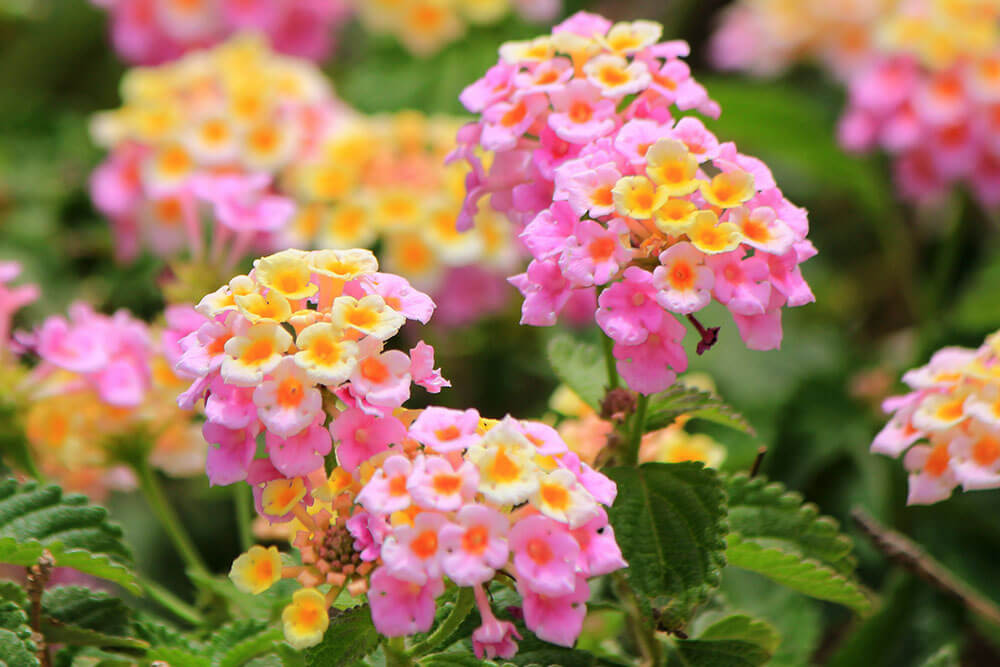
Unlike the plants above, lantana is native to the Americas. It’s tough enough to survive a Texas summer on nothing but the rain and come up smiling, yet despite its grit, it’s actually quite elegant. It blooms with delicate (yet surprisingly long-lived) mini-bouquets of confetti-like pink, red, white, and yellow flowers all summer long, lending some much-needed cheer to wilting summer garden. Their flowers are also irresistible to butterflies, hummingbirds, and other pollinators – but the whole plant is toxic to deer and squirrels, which avoid them completely.
Like plumbagos, lantanas are most at home in warm gardens; while they’re hardy to zone 7, north of zone 10 they’ll have to be cut back to the ground each winter. However, they’re such vigorous growers — even under less than ideal growing conditions — that you probably won’t notice: plants that start growing in early spring can easily reach head-height by summer’s end.
7. Bougainvillea (Bougainvillea spp.)

Bougainvilleas are a bit of a stretch for this list, since they’re not really shrubs at all, but vines. However, they’re surprisingly sturdy and shrub-like vines, and easily be trained into bushy shapes that don’t require support. Then too, their “flowers” aren’t actually flowers at all, but specialized leaves called bracts; the real flowers, hidden within the bracts, are tube-shaped and inconspicuous.
But why quibble over semantics? Shrub or vine, bract or petal – when it comes to show-stopping flowering shrubs, bougainvilleas definitely belong on the list. Like plumbagos, happy bougainvilleas don’t really stop blooming – they just take breaks. Usually, plants will bloom for about a month, rest for a month, and then do it all over again. In climates with cooler winters, this cycle might last eight or nine months, with a dormant period in the winter – but in warmer areas, they’ll just keep going.
8. Pride of Barbados (Caesalpinia pulcherrima)
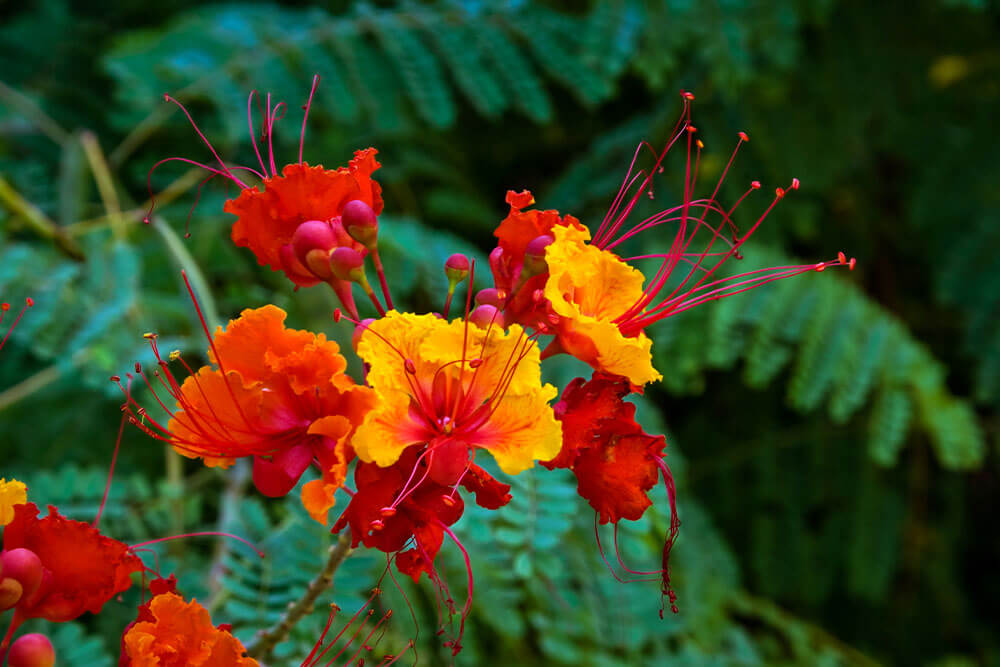
Pride of Barbados, sometimes called “bird of paradise” (but not to be confused with the numerous other plants that go by this name), is an elegant, slender shrub that’s a lot hardier than its delicate appearance suggests. Like other plants in the legume family, it gets nitrogen from bacteria living in its roots, which allows it to thrive in low-fertility soils, and it tolerates drought and heat extremely well.
Of course, hardiness alone doesn’t earn you a name like “Pride of Barbados,” which refers instead to its delicate two-toned red and yellow flowers. These are decorated with whimsical, whisker-like stamens, but like the shrub itself, the flowers are deceptively fragile-looking. In some climates, these plants don’t even start blooming until June, and will carry on right up to the arrival of winter.
Sadly, Pride of Barbados is only frost-hardy to zone 9, meaning it can only be grown in far-southern gardens. However its close relative, the equally beautiful dwarf poinciana (C. gillesii), can overwinter as far north as Kansas and Virginia if grown in a sheltered location.
9. Flame acanthus (Anisacanthus quadrifidus)
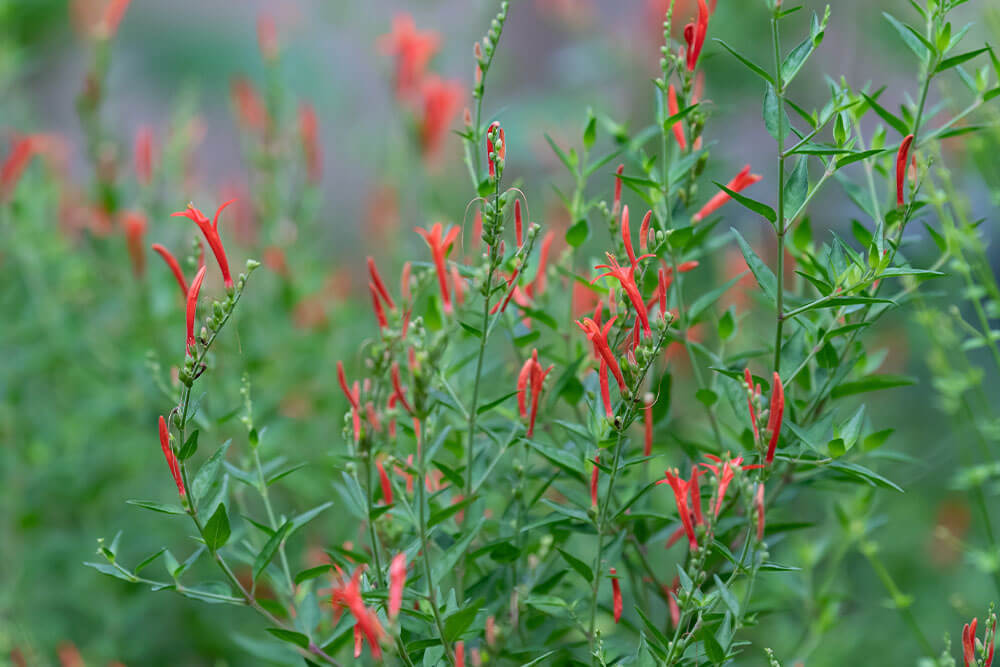
Flame acanthus is named for its incandescent flowers – but the “flame” might just as well refer to the plant’s unbelievable tolerance for heat, drought, and exposure. In fact, flame acanthus positively thrives under these conditions: like Pride of Barbados, it does its blooming in the heat of summer, and its red, honeysuckle-like flowers attract hummingbirds like moths to a – well, you know.
Flame acanthus, like lantana, is native to the rocky desert scrub of northern Mexico, and it also has a fairly moderate tolerance to cold: it’s a good choice for zones 7 through 11, though in zones 7 and 8 it may die back to the roots. If you live in a dry area – or if you keep your acanthus in containers – try soaking the plants after a long dry spell. This mimics the summer thunderstorms that, in their native habitat, stimulate the plants to bloom even more profusely.
10. Forsythia (Forsythia spp.)
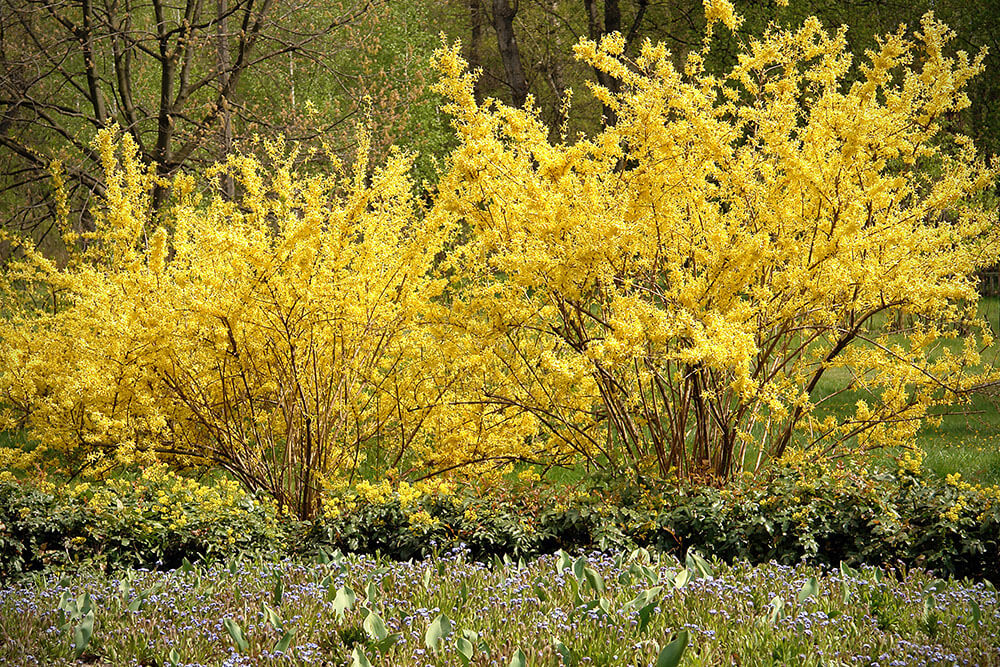
Forsythia is often called “harbinger of spring” and “Easter tree” – a name that somehow seems appropriate even when the plants can’t wait until Easter to flower. Forsythia blooms when frost is still on the ground, and it makes an explosive statement: flowers sprout from every twig, and clothe the bare branches so richly you might think they’re leaves (though like cherries, forsythias bloom before they leaf out). It’s an exuberant and heartening reminder of warmer weather to come – even if it’s still months away.
In addition to their riotous blooms, forsythias are also quite easy to grow. Like willows, they propagate easily from stem cuttings, and will tolerate almost any conditions they find themselves in, from drought to thick clay. In fact, their only real requirement (besides full sun) is a mild winter: the plants themselves are hardy between zones 5 and 8, but the flowers, which bud over the winter, can be killed by late cold snaps.
11. Shrubby cinquefoil (Potentilla fruticosa)
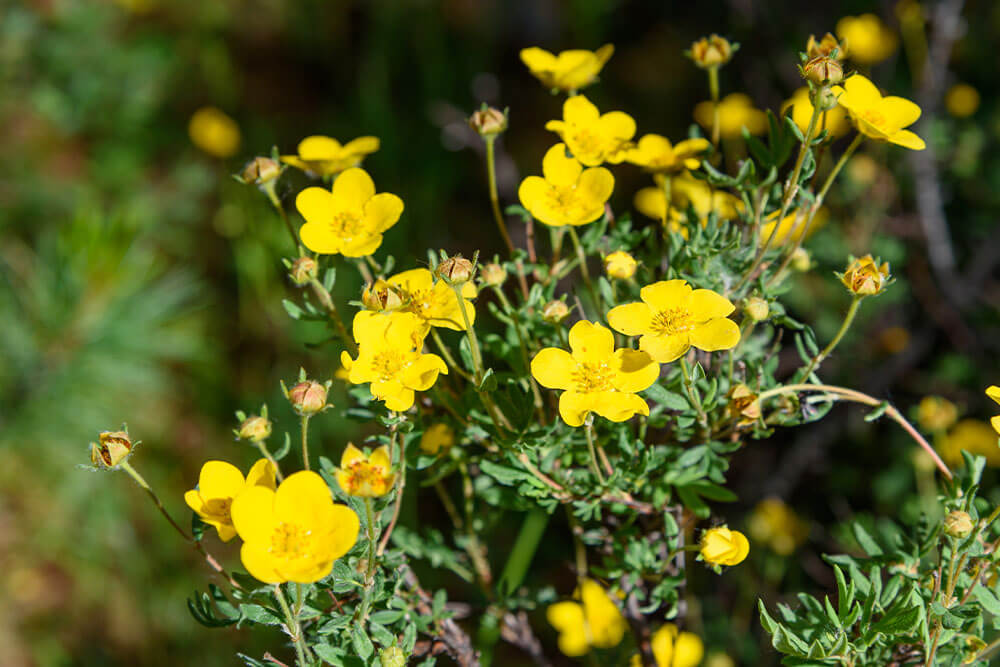
Shrubby cinquefoil is sometimes referred to simply as “potentilla,” a generic name for a number of easygoing garden plants in the rose family. The genus Potentilla, closely related to strawberries, is remarkably diverse, including everything from creeping annuals to leggy shrubs. Shrubby cinquefoil – named for its five-part compound leaves – is definitely one of the latter.
It is in every way an easy plant: easy to grow, easy to love. It’s hardy between zones 2 and 7, highly drought-tolerant, and will even tolerate part shade (although it blooms best in full sun). Its flowers aren’t especially large or striking – but they’re quite charming and long-lived, not to mention prolific.
They’re particularly effective in mass plantings, and well-maintained – or well-contained – plants resemble miniature hills studded with wildflowers. However, keeping your plants contained is not as simple as getting them going in the first place. If you find your plants continually overstepping their bounds, just prune them hard in the winter: they’ll be back next spring with no hard feelings.
12. Crape myrtle (Lagerstroemia indica)
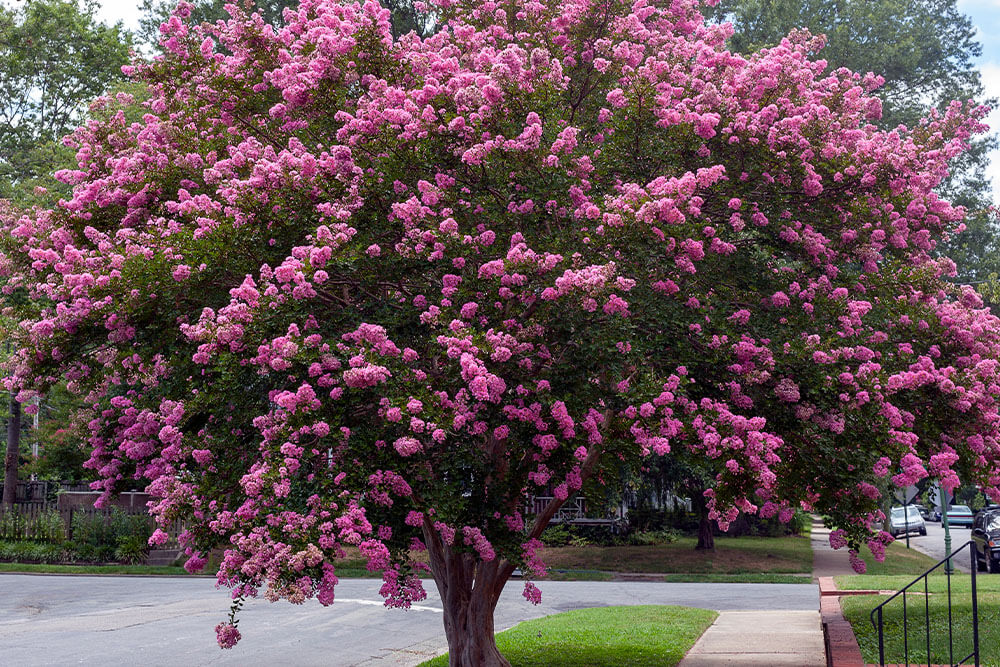
Crape myrtle is sometimes called the “lilac of the South,” and there’s more than a hint of that famous shrub in the show-stopping pink, red, and purple blooms — but crape myrtle is far more than a heat-tolerant lookalike.
For one thing, lilacs only bloom for a week or two each spring; crape myrtle’s flowers emerge in the summer and last for months. And even when the flowers do finally drop off, crape myrtles still have plenty to offer, from their fall color to their lovely, sycamore-like exfoliating bark. (They’re also much better-behaved: unlike lilacs, crape myrtles rarely require pruning and don’t produce “suckers” from the roots.)
Crape myrtles are definitely on the larger side of “shrub,” and they need more space than many of the plants on this list – both horizontal and vertical. Space-limited gardeners might consider dwarf crape myrtles, which at 4-5 feet high offer all the spectacle of the full-sized plants in a fraction of the space.
13. Viburnum (Viburnum spp.)
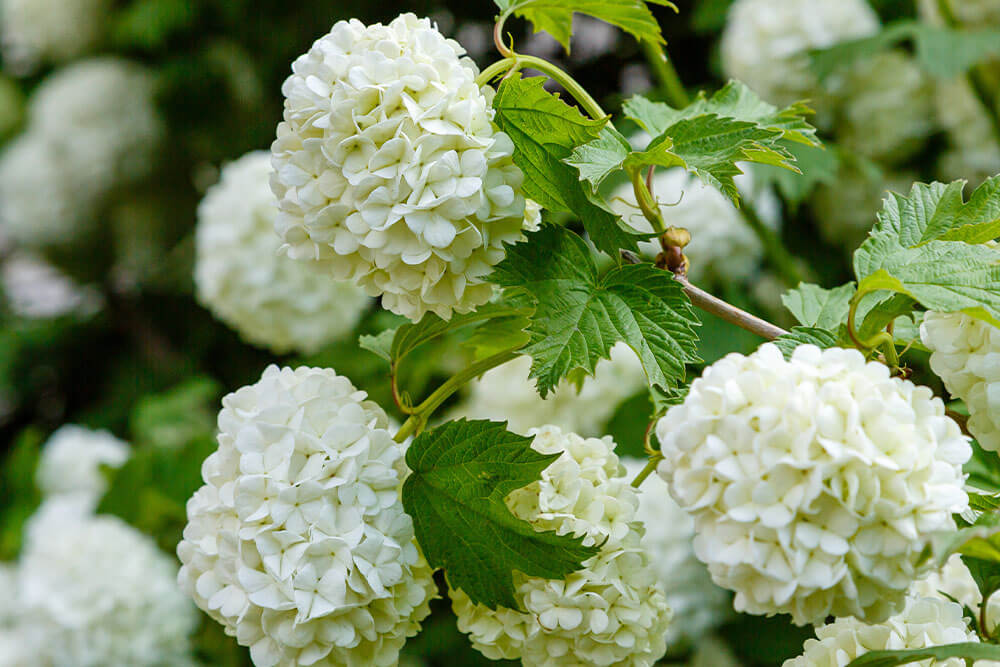
Viburnums are sheer beauty in shrub form – everything about these graceful shrubs, from root to crown, is appealing. They’re probably best known for their snow-white flowers, which are borne on tight, hydrangea-like clusters, and last from early spring to mid-summer (though a few species are winter bloomers). The flowers aren’t the end of the story, though: they ripen into glossy, scarlet fruits that are as attractive to wildlife as they are to people. Many species also have spectacular fall color, with reds and golds that will make you forget all about maples.
Beautiful as they are, these compact shrubs are surprisingly low-maintenance, and adapt readily to a huge range of growing conditions. The most common ornamental species, the guelder rose (V. opulus), is cold-hardy all the way to zone 2, and native gardeners will be happy to know that some of the most beautiful and beloved ornamentals are hardy natives, including mapleleaf viburnum (V. acerifolium) and arrowwood (V. dentatum).
14. Flowering Quince (Chaenomeles speciosa)
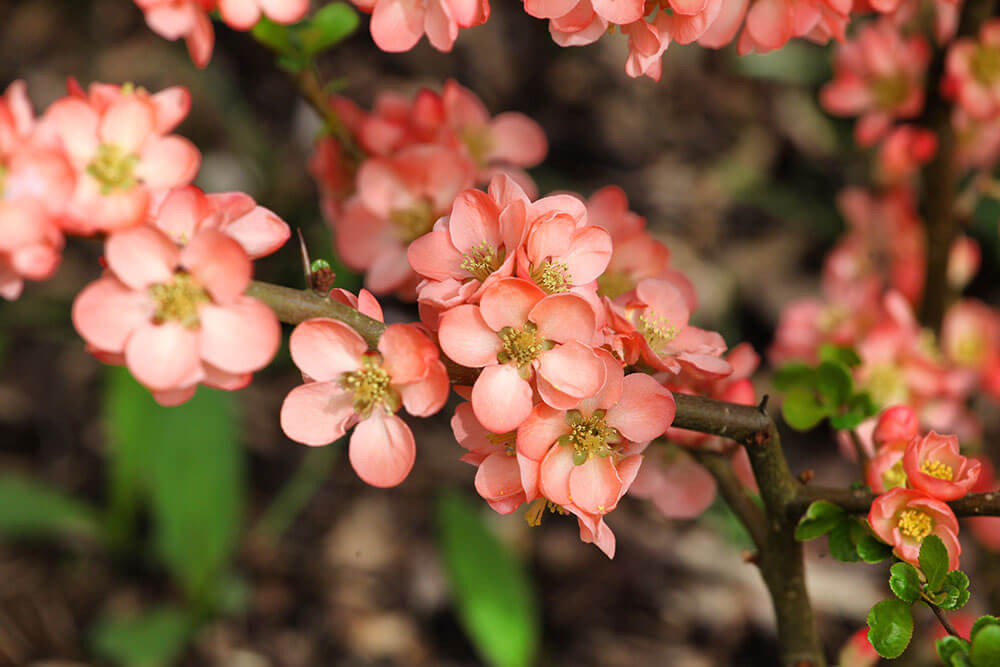
Flowering quince’s species name – speciosa – is Latin for “showy,” and the epithet is well-deserved in more ways than one. Of course there are the flowers: like its cousins the cherries, flowering quince blooms very early in spring, serving generous portions of pink, orange, and red that contrast beautifully with its bare branches. By spring, these are replaced by golf-ball shaped fruits that look like tiny apples, which ripen from granny smith green to golden delicious over the summer. (Pruning will increase flowering, but will also result in fewer fruits.) It’s winter-hardy to zone 2, and tolerates most soil conditions (besides high pH).
Despite the similarity of its flowers and fruits to cherries, peaches, or apples, flowering quince is not a tree but a shrub. However, it has a tendency to spread messily via suckers, which may make it difficult to integrate into smaller gardens. Fortunately, the closely related Japanese quince (C. japonica) looks quite similar, but generally reaches only 2 or 3 feet high. Japanese quince tolerates heat better than flowering quince, but doesn’t do well in cold climates: it’s only winter hardy to zone 5, while flowering quince can be grown as far as zone 2.
15. Cenizo (Leucophyllum frutescens)
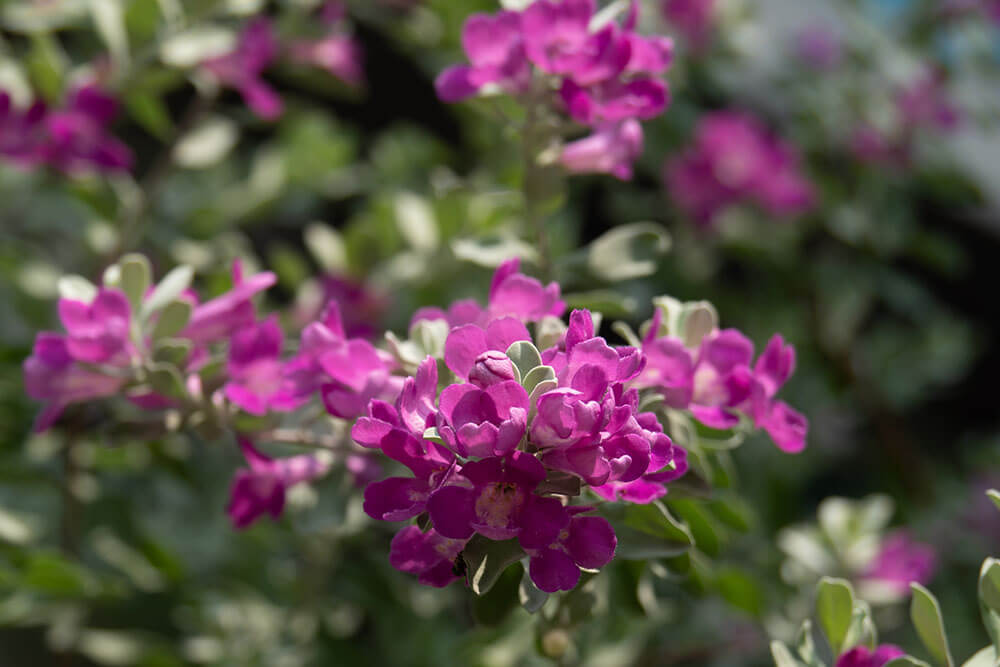
Cenizo, also called desert sage, is an exceptionally drought-hardy – and exceptionally beautiful – native shrub that grows in the deserts of the American Southwest. It has appealing silvery-gray leaves that get their hue from tiny hairs on the leaf surface that prevent water loss through evaporation. Its flowers are small but numerous, and their magenta color complements the foliage perfectly.
Cenizo handles drought and heat unlike any other shrub on this list, but it does have an Achilles’ heel: in poorly-drained soils, it can quickly develop root rot and die. In gardens with mucky soil, raised beds can help keep the plants’ roots out of standing water. Cenizo is also the rare garden plant that thrives on alkaline soils, and often benefits from powdered limestone dusted around the base of the plant.
15 Flowering Shrubs That Stun in Full Sun
The plants on this list, as beautiful as they are, are just the tip of the iceberg when it comes to flowering shrubs for full sun. There’s a whole world – a whole galaxy – of beautiful ornamentals out there, and no matter where you are or what your garden needs, there’s a shrub out there that’s just right. Don’t be afraid to ask for recommendations: nursery employees, university extensions, master gardeners will all have good advice that’s tailored to your specific region and your specific garden. Now get out there and get your hands dirty!
[wp-faq-schema title=”Frequently Asked Questions About Flowering Shrubs” accordion=1]